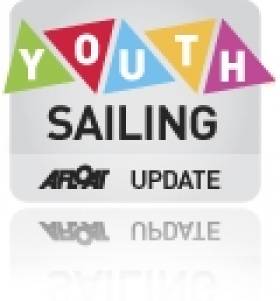Displaying items by tag: Laser Sailing
Irish Laser Sailing Youths Punch Above Their Weight in Germany
The Laser Under–21 World Championships is being held in Kiel, Germany this week. The event is a follow–on regatta to the KBC Laser Youth Worlds recently held at the Royal St. George Yacht Club, at which Irish sailors performed so well, including a Silver medal for Ewan McMahon of Howth Yacht Club.
The National Yacht Club’s Nicole Hemeryck, one of the top performers in the Worlds – seventh overall and first Irish girl – is presently lying 13th, while Lough Derg Yacht Club's Aishling Keller who represented Ireland successfully in the 2015 ISAF Worlds (10th overall) is presently 20th. Other promising upcoming Irish sailors Jenny Fekkes and Sally Bell are lying 30th and 32nd respectively in the fleet of 57 of the top sailors from 28–nations.
 Some of the Irish Laser youth sailors in Kiel Germany this week. Photo: Facebook
Some of the Irish Laser youth sailors in Kiel Germany this week. Photo: Facebook
The increased age range of the Under–21 Worlds presents a new challenge to Irish youth sailors but they are punching above their weight in Kiel.
In the standard class, former ISAF silver medalist Seafra Guilfoyle returns to form after a back injury saw him drop out of the Olympic Laser trial earlier this year.
The sailors return to Dublin on Wednesday, with an overnight stop before they commence competition in the Irish Laser Nationals at Galway Bay Sailing Club this Thursday.
Meanwhile, the Laser Radial Youth Europeans have conclude in Estonia. Details are here.
Clyde SB3 Class Continues to Grow
Following beer and pizza a 40 minute presentation was given which was followed by an open question and answer session. The presentation covered a range of points including; an overview of the boats, opportunities for the 2012 season, berthing & launching facilities, available boats and sponsorship opportunities. Feedback from those that attended would suggest that the evening was a success and we are now aware of a further 2 definite owners presently looking for boats as well as 4 other individuals or syndicates giving the opportunity serious consideration.
At the request of some of the attendees we will be holding a demo sail weekend on Saturday 26th November between 11:00 – 14:00 (weather dependent) where interested owners and crew can come and try out a boat. If you are interested and have not already registered for a demo sail, can you please email Douglas Paton ([email protected]) with your preferred time.
Top Five Start for O'Dowd
Fresh from a top ten finish at the ISAF Youth Worlds, Dun Laoghaire sailor Matthew O'Dowd has started the Radial Youth World Championships in Largs with a second place finish.
The Laser fleet numbers some 210 boats, and has been split in three for the initial group stages. O'Dowd's second place in his 70-boat group puts him in fifth overall and sets a good tone for the rest of the regatta.
The Worlds, held in Largs, Scotland, lost its first day to light airs and had to wait until late in the afternoon yesterday to get racing in, whena steady, building northerly breeze trickled down the Clyde this afternoon allowing racing to commence.
The conditions were far from what the senior Radial fleet experienced at their world championship the previous week when gusts of 40kts swept through the fleet, but adequate enough to allow the 320 competitors to enjoy the first tactical race of the series.
Sailing on ‘home waters’, it was good to see 16-year-old GBR sailor Elliot Hanson demonstrating why he is one of the hot favourites here this week. Hanson finished sixth on these same Clyde waters last week at the Laser Radial World Championships. A former Topper UK national and world champion he benefited from the leading Hungarian’s windward mark-rounding error, and enjoyed a good race with Matthew O'Dowd (IRL), to win the one and only race of the day on the Boys’ course. Tadeusz Kubiak (POL) was also on top form winning Blue fleet, while Matthew Mollerus (USA) has made his intentions clear by winning the Red fleet.
On the girls’ course, set further to the north of Cumbrae, the situation was equally exciting with Julia Vallo Arjonilla (ESP) winning the first race in the Blue fleet and finishing third in Race 2 which puts her in a leading overall position. Pauline Barwinska (POL) snatched a win in Yellow fleet when Marketa Audyova (CZE) who crossed the line first, was deemed OCS.
Barwinska, fresh from competing at the Volvo Youth Sailing ISAF World Championship in Turkey is another race sharp sailor who showed she’s a real force to be reckoned with. She’s only been competing at international level for one year, so today’s result has given her a massive boost. The Japanese girls are also on top form with Manami Doi, and Momoko Tada taking wins in the second races (Yellow and Blue fleets).
Elliot Hanson (GBR): “We had quite tricky conditions to start with because the wind was up and down. I was second round the windward mark and then managed to chop and change with Matthew Odowd until the last run when I just managed to pull away. We started off with the most wind of the day at 12kts from the north generally. There were more pressure changes than shifts. The key today was to keep the speed up and reach the first windward mark in a decent position. But I think staying in the highest pressure was the key factor of the day. Some of the other British sailors did well today too and Cam Douglas – who was at the ISAF event, and John Currie who was second at the Youth Trials – are definitely two I’ll be watching out for this week.”
Full results from the event are HERE.































































